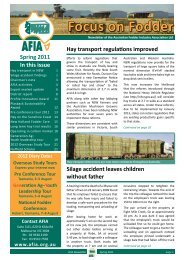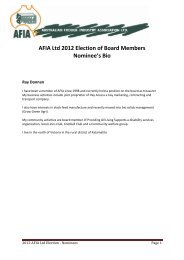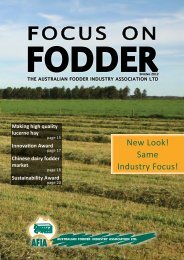AFIA - Laboratory Methods Manual - Australian Fodder Industry ...
AFIA - Laboratory Methods Manual - Australian Fodder Industry ...
AFIA - Laboratory Methods Manual - Australian Fodder Industry ...
Create successful ePaper yourself
Turn your PDF publications into a flip-book with our unique Google optimized e-Paper software.
Step 2:<br />
Convert the result to a true DM basis:-<br />
Ad<br />
(Af × 100)<br />
=<br />
TDM<br />
where TDM = true DM content of the silage (g/kg)<br />
Step 3:<br />
Express the result as a % of total N (g/kg true DM) previously determined by Kjeldahl digestion<br />
% Silage NH3-N of total N = Ad x 100<br />
% N<br />
Where % N = Total % nitrogen corrected for true DM content of the silage.<br />
Comments:<br />
• Silage is a fermented feed and the extent of breakdown of the protein or nitrogen (N)<br />
fraction is a good indicator of silage fermentation quality. During the early stages of the<br />
ensiling process, while anaerobic conditions are being established, and before there has<br />
been a significant drop in pH, breakdown of the protein in forage (proteolysis) commences<br />
due to the activity of plant enzymes. Further protein degradation can occur due to the<br />
activity of undesirable bacteria, particularly if there is a delay in achieving anaerobic<br />
conditions and/or there is a slow fall in pH. The ultimate breakdown product from this<br />
process is ammonia-N. High levels of ammonia-N, expressed as a % of total N, are an<br />
indicator of extensive protein breakdown and poor silage preservation. Ammonia-N is an<br />
excellent indicator of silage fermentation quality, and for an interpretation of these results<br />
refer to Kaiser and Piltz (2003).<br />
• Silage is a perishable product and should be stored in a sealed bag (anaerobically) at low<br />
temperature. If the sample is not to be analysed immediately it should be frozen.<br />
• The use and interpretation of ammonia-N data as a measure of silage fermentation quality<br />
is provided by Kaiser and Piltz (2003)<br />
• Refer to the method for determining total N in silage. Where total N is determined on an<br />
oven dried silage sample, failure to take account of the loss of volatile N will influence the<br />
calculated result (% or g/kg total N). Also where total N is determined by the Dumas<br />
method rather than the Kjeldahl method, some adjustment may be required for any<br />
differences between the two methods in the total N result.<br />
References:<br />
AOAC Official Method 2001.11: Crude protein in animal feed, forage, grain and oilseed.<br />
Kaiser, A.G. and Piltz, J.W. (2003). 12. Feed testing: assessing silage quality. In: “Successful<br />
Silage”, eds A.G. Kaiser, J.W. Piltz, H.M. Burns and N.W. Griffiths (Dairy Research and<br />
Development Corporation and NSW Agriculture: Australia), 24pp.<br />
<strong>AFIA</strong> <strong>Laboratory</strong> <strong>Methods</strong> <strong>Manual</strong> – v7 September 2011 Page 30 of 103







